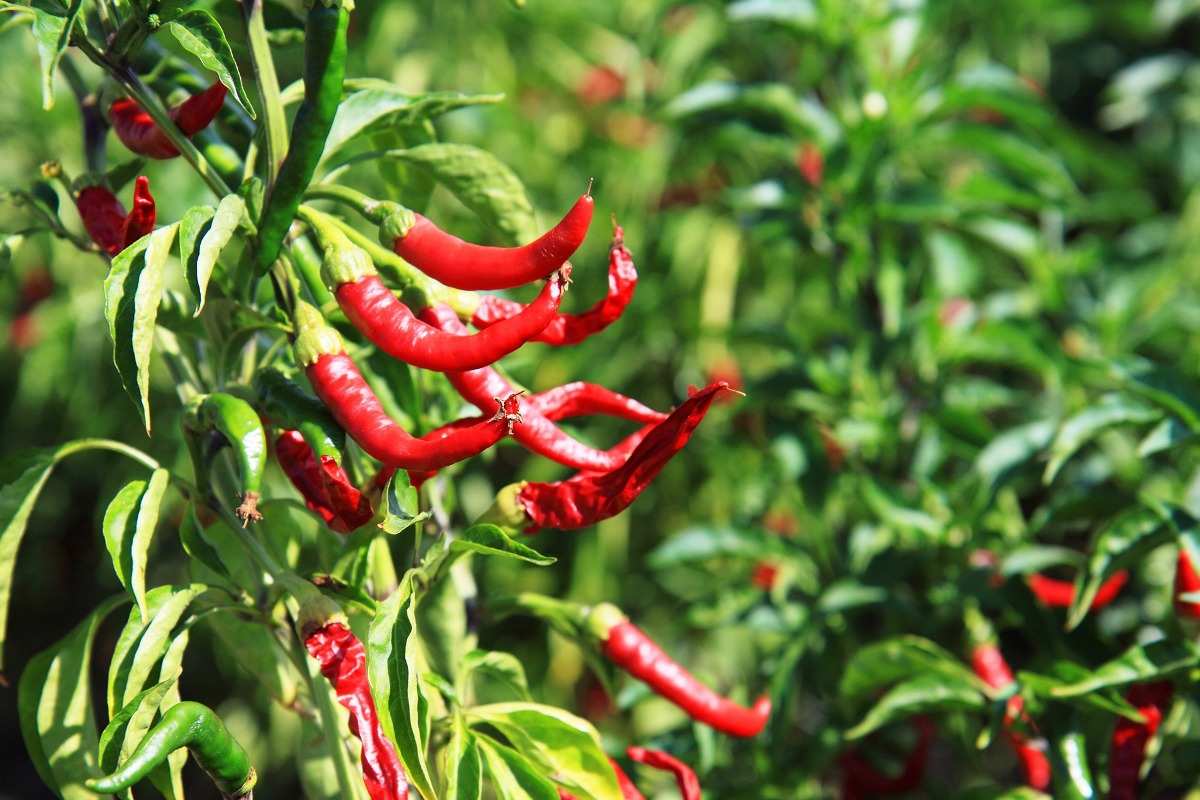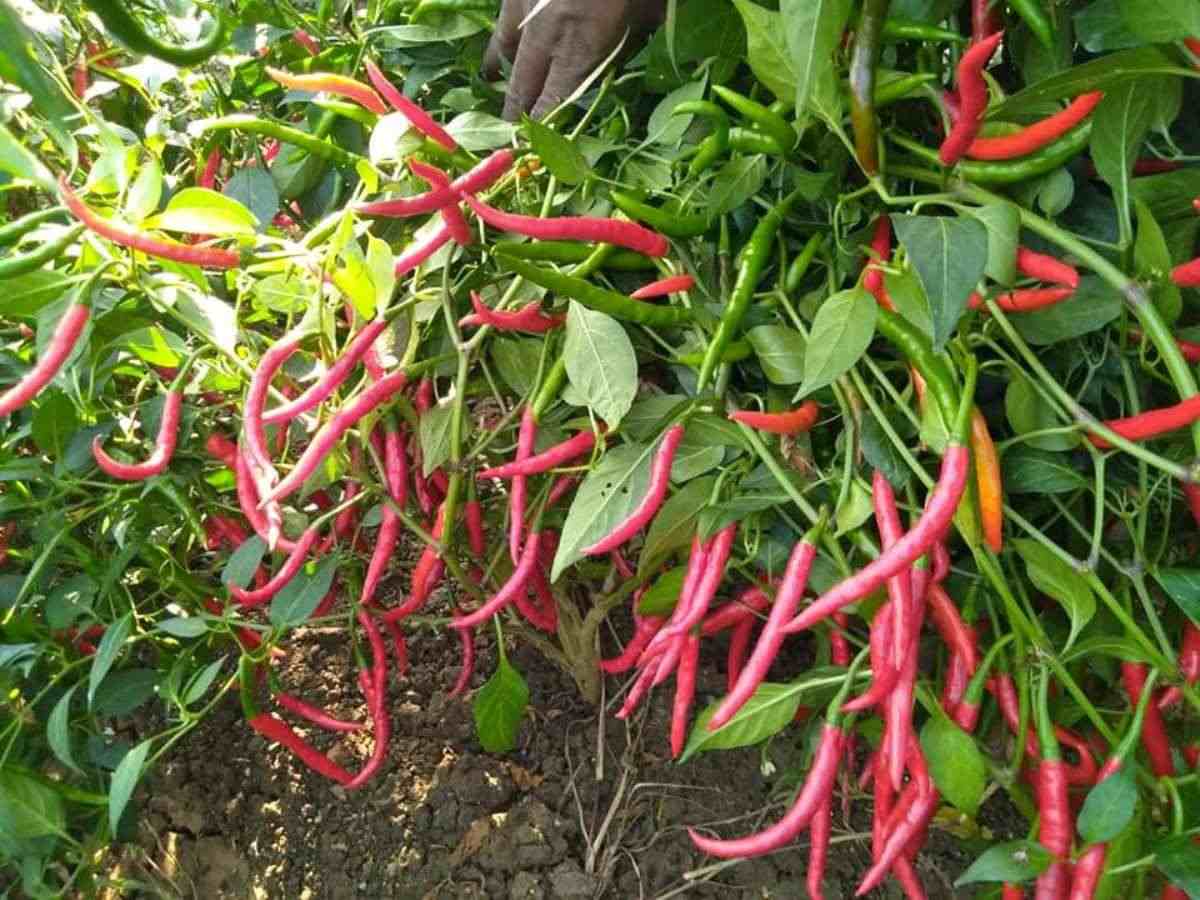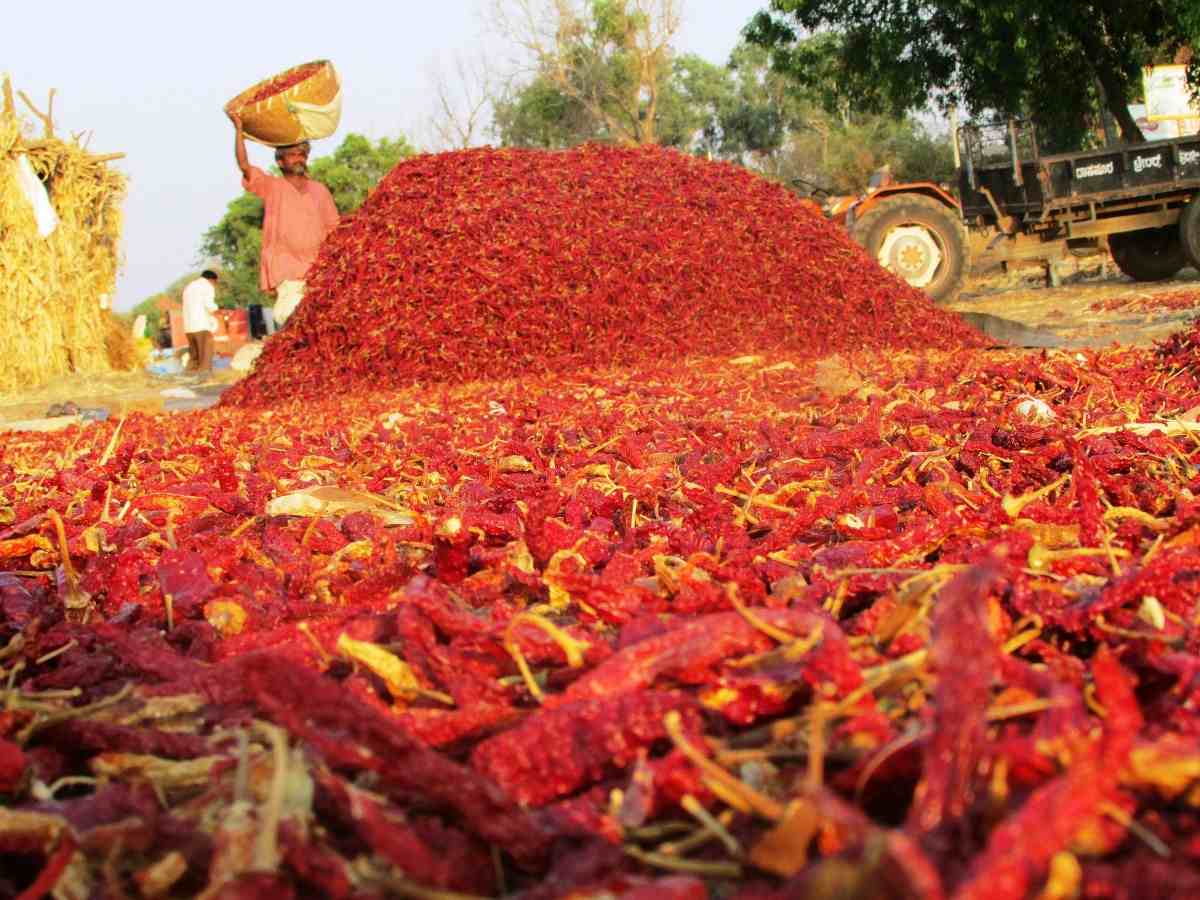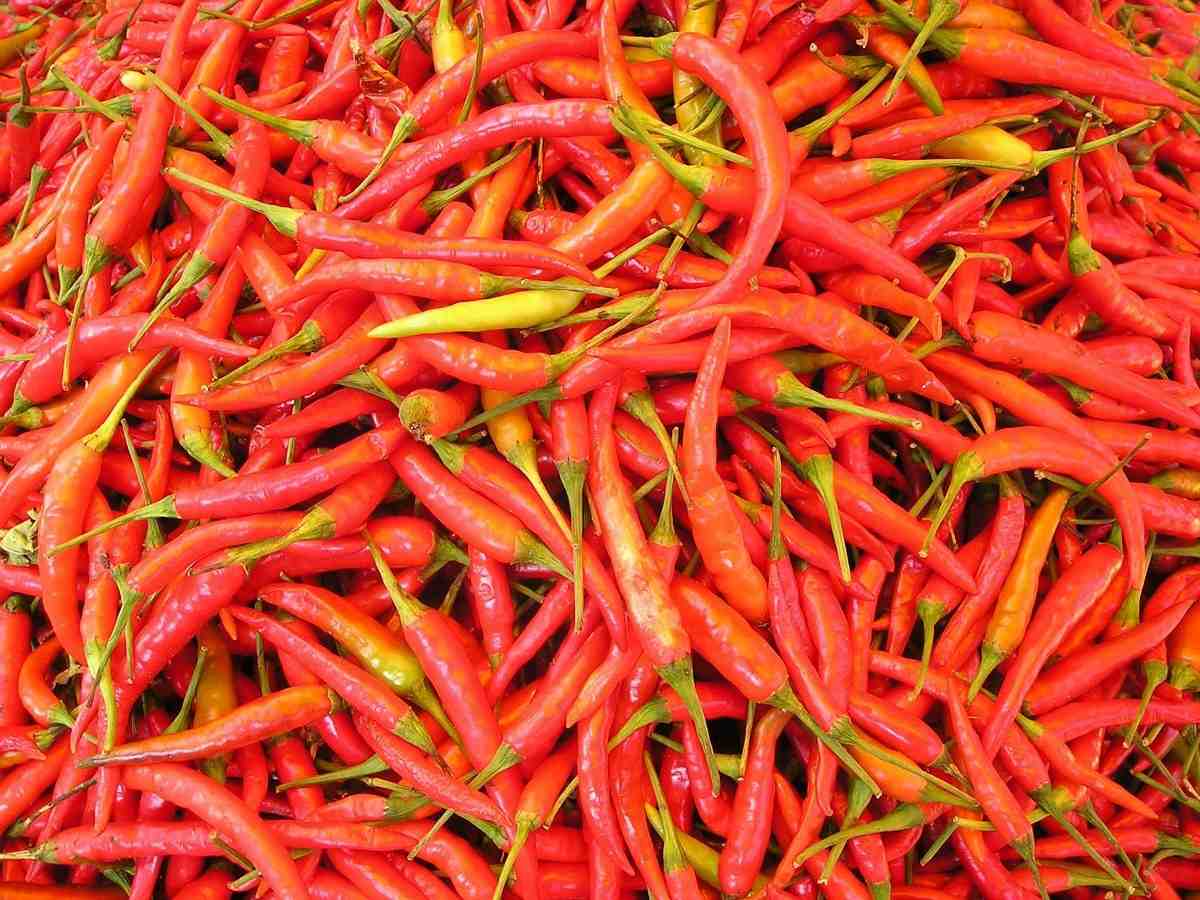Introduction to Chilli varieties in India: Chillies are also known as Mirchi in India. Chillies are not only used in Indian food but also used in Ayurveda. Chillies are extremely crucial for several world cuisines, particularly Indian food where no dish is complete without a little sprinkling of this spicy flavor note.
A step by step guide to Chilli Varieties in India
Andhra Pradesh is the primary producer of Chillies in the country followed by Karnataka, Rajasthan, Gujarat, etc. It is the dried ripe fruit of the genus Capsicum. It is one of the most important commercial crops in India. There are several varieties of Chillies and each unique in color and flavor. Spices Board of India identifies 18 varieties of Chillies that are grown in different parts of the country. These contain Bird’s eye Chilli (Dhani), Byadagi (kaddi and daggi), Ellachipur Sannam, Guntur Sannam, Hindpur, Jwala, Kanthari White, Kashmiri Chilli, Madhya Pradesh Sannam, Madras Puri, Nagpur, Nalchetti, Ramnad Mundu, Sangli Sannam, Sattur, Mundu, Tadappally, and Tomato Chilli.
Conditions for Chilli cultivation
Chilli is grown almost throughout the country. There are more than about 400 different varieties of Chillies found all over the world. It is also called as hot pepper, sweet pepper, and bell pepper, etc. These are used in cooking a wide range of food items such as spicy curries, chutneys, and pickles.
The main Chilli growing states in India are Andhra Pradesh, Karnataka, Maharashtra, Odisha, Tamil Nadu, Bihar, Uttar Pradesh, and Rajasthan. And these states account for nearly 80% area under Chillies cultivation in India. It can be grown all types of soils from light sandy to heavy clay. Optimum soil pH level for Chilli is 5.8 to 6.5. And very sensitive to waterlogging. Thoroughly plough the land 3 to 4 times followed by planking to level the field.

Chilli plant cannot withstand water stagnation and excess moisture, therefore light irrigation proper drainage is recommended. Generally, the crop is irrigated at an interval of 5 to 6 days in summers and 9-10 days in winters. Sandy soils require frequent irrigation than clay soils. It is required to test the soil once a year to check the pH levels, organic carbon, macronutrients (NPK), micronutrients and microbial load in the field. If the organic carbon content is less than 1%, apply 20 to 25 tons/ha of FYM and plough the field 2 to 3 times to mix the manure thoroughly.
You should not miss the Subsidy for Composting, Organic Farming.
Sowing of chilly starts in July and continues till August-September and it is cultivated as a Kharif crop. The seed rate of Chilli is 2.5-3.0 kg per acre. Seeds must not be treated with any chemical fungicides or pesticides. The Chilli seeds may be treated with Trichoderma and Psuedomonas sp. @ 10 g per kg of Chilli seed to prevent the incidence of seedling rot in the nursery. Treatment of seed with cow pat pit, beejamrut, amrut pani, panchagavya or trichoderma ensure a good crop yield and a healthy crop and will protect the crop from disease.
Regular irrigation is a very important factor for the successful production of Chilli crop. The first irrigation is given at the time of transplanting and the subsequent irrigations are given once in a week or 10 days depending on the weather condition and soil moisture condition. In light soils, irrigation is given at 10 to 12 days intervals, in black cotton soils at 3-week intervals and in summer at 5 to 6 days interval.
Chillies suffer from a variety of pests and diseases that may contain greenfly, potato blight, thrips, blossom end rot, and botrytis. They can affect the lush growth of the plants and lead to the decrement in the health of the plant. Plants should never be overwatered as the leaves could turn yellow indicating suffocation from soggy soil and they shrivel up and die if left unchecked. They should be kept in small pots and general compost must be used for good drainage.
Chilli seeds can be planted into pots and firmed down to the soil by using compost and soaked thoroughly. The Chilli seeds require good space between them so that their roots are not harmed when they will be potted. If the soil is poor, it can be fertilized keeping in mind Chillies like potassium as too much can soften the leaves with no fruit production.
Chillies could be harvested green or left to ripen on the plant. The ripened color will mainly depend on the variety grown and can be red, yellow, orange or black. If they are left in the plant until they are ripened, the Chillies will have a sweeter flavor.
The yield of fresh chilly varies from 30 to 40 q/acre depending on variety and growing conditions. The yield of dry chilly is expected to be in the range of 7.5 to 10 q/acre. Now, let’s get into the details of very popular commercial chilli varieties in India.
Most popular varieties of Chilli found in India

Bhut Jolokia, North East India – World’s Hottest Chili
Bhut jolokia is also known as ghost chili or ghost pepper is mostly cultivated in the Northeast states of India. It is currently considered the hottest pepper in the world. Though, while it is a difficult pepper to raise, its high soil temperature needs make it a good candidate to grow indoors for those willing to brave its picky nature. This Bhut jolokia is used as a food and a spice in northeastern India in both fresh and dried forms, the pods are unique among peppers and color as well.
Naga Chili, Nagaland
Naga Chilli is also called Naga Morich, is a small but hottest chili pepper cultivated in Northeast India, especially in Nagaland and Manipur. The Naga chili is related to the Bhut jolokia and listed as one of the world’s hottest known chili from India.
Naga Viper pepper is hybrid chili varieties created in England by chili farmer, produced from the Naga Morich and the world’s most famous and hottest Bhut jolokia.
You may also like the Horticulture Practices in Summer.
Naga Chilli plants are nightshade plants and belong to the species of Capsicum chinense. This genus is represented among the top ten hottest Chillies in the world. The plants of this type of chili generally grow to a height of about 80 cm. They look extremely fine when fresh green plants carry red Chillies and this plant needs 8 to 9 months from sowing to harvest, you should start growing it indoors as early as January. A heated mini-greenhouse with 27 °C and high air humidity provides a good germination climate.
Kashmiri Chillies, Kashmir
As the name suggests, this Kashmiri Chilli is found in Kashmir and is the most sought after red Chilli in India for its color. An Indian kitchen is incomplete without Kashmiri mirch as this adds the color to the mouth-watering dishes every household cooks. This Kashmiri chilly is less hot or pungent, as compared to the other variants found in India.
Kashmiri Chili is popular as a color agent and used across the country in many dishes. Red chili powder from Kashmir is mild and one of the must-have spice to many Indian cuisines. Kashmiri Chilli as the name suggests is produced in colder regions of Kashmir and most sought after red Chillies in India for its color.
Guntur Chilli, Andhra Pradesh
Andhra Pradesh is known for its spicy dishes and credit goes to Guntur Chillies, from Guntur district of the state. Guntur Sannam is one of the types of Guntur chilly, is also cultivated in Madhya Pradesh. Guntur chili from Guntur district is renowned globally and the red chili powder Guntur is exported to countries in the Middle East and Latin America.

Guntur Chilies do offer different types, different colors, and flavors for curries and dishes. Guntur Sannam S4 Type is the best type of Guntur chili and registered as one of the geographical indications of Andhra Pradesh.
Sannam Chilli varieties of India
Sannam Chilli is the king of the red Chilli variants found in India and is mainly produced in the regions of Andhra Pradesh and Madhya Pradesh. Though, the best of Sannam Chilli is produced in the Guntur region of Andhra Pradesh. Popularly known as Sannam S4 or 334, this is hot, medium-sized and bright red colored Chilli highly in demand because of its mouthwatering aroma, flavor, and medium pungency. This Sannam Chilli is widely used in Indian, Chinese, European, Mexican and Japanese cuisines. It’s not only about the taste, but this spice also adds up to health by stimulating your appetite, digestive system, and blood circulation.
Jwala Chilli, Gujarat
This jwala Chilli is also known as finger hot pepper, is primarily grown in Kheda, Mehsana and southern parts of Gujarat. They can also be grown at home. This Chilli is easily obtainable in the market throughout the year and very pungent in flavor. This chili is long, twisted, and cayenne type chili from Gujarat is the most popular Chili in India, majorly grown in Kheda and Mehsana. It one of the most famous and one of the many varieties of chilies grown in India.
Jwala Chilli is medium-sized plants grow about 4-5 inches. These Chillies start with green color, on maturity they turn into a beautiful bright red Chilli. This is the popular red Chilli of the west. It’s highly pungent, light red-colored Chilli used in various cuisines of the state.
Kanthari Chilli, Kerala
Kanthari Chilli is grown in Kerala and some parts of Tamil Nadu. It is also called as Kanthari Mulaku, Dhani, birds eye Chilli of Kerala and become white when matures. It adds heat and lends good flavor to many dishes. Kanthari chilies are well known as bird’s eye chilies and host list of health benefits, grown in the Kerala state of India. Kanthari chili variety commonly found across Southeast Asia, grown in Indian states of Kerala and North East. Kanthari Chilli is a chili pepper commonly found in Kerala, Meghalaya and few other Asian countries. Kanthari chilies are very small in size (not more than 2-3 cm) yet pungent and hot, these chilies will make your eyes water if you eat one. Most Kanthari Chilli sold in the Kerala market are hybrid ones, It will be larger in size and mild in flavor and spice content.
In case if miss this: High Yield Vegetable Crops for Maximum Profits.
Kanthari Chilli known for its strong pungent smell and heat, it is blood red. Dhani is popularly called the Bird’s Eye Chilli because of its shape; it is widely produced in Mizoram and some areas of Manipur. Though the tiniest, this is a spicy, highly pungent and bright red colored Chilli which is widely available in markets of Calcutta
Byadagi Chilli, Karnataka
Byadagi is a famous variety of Chilli, mainly grown in Karnataka. It is named after the town of Byadagi, which is located in the Haveri district of Karnataka. Known for its color and pungency, byadagi is similar to paprika. Byadagi Chillies are grown in Dharwar, Karnataka as well as in parts of Goa. The Byadagi dried Chilli is deep red in color with a mild pungency but aromatic flavor. Apart from Karnataka and Goa, Kerala and Maharashtra use it in their cooking.
Byadagi Chillies, on the other hand, are a favorite because of the bright red hue that they render to the preparations. These are long and slightly fat. They are great for making blended spices. These are used by Maharashtrians for a spicier version of their traditional goda masala. Byadagi chili is the important and very popular variety of chili in India, mainly grown in the town of Byadagi in the Haveri district of Karnataka. Byadagi is less spicy and known for its deep red color, also has been tagged with Geographical Indication (GI) product of Karnataka.
This Chilli is produced in the byadagi region of the Haveri district of Karnataka. These are wrinkled, long and dark red colored Chillies acclaimed for their ability to retain their nutritional values for a longer period. Not only does it enhance the flavor of food, but it also instills health enriching vitamins and minerals like manganese, foliate, potassium, thiamin, vitamins A, B, C and E in it. This is obtainable in various forms in the market like byadagi Chilli with stem, without stem, crushed dry red Chilli flakes, and dried red Chilli pepper powder.
Mundu Chili, Tamil Nadu
Mundu Chilli is a round-shaped Chilli, grown in ramnad district in Tamilnadu, India; it is also called as ramnad S9 red mundu Chilli. Especially, Mundu red Chilli is popular in south Indian cuisine, it has dark shiny and thick skin. Available with or without the stem.
Ramnad Mundu or Gundu is the fat round Chilli produced in fertile regions of Ramnad in Tamil Nadu. This mundu is chilly widely preferred to add spiciness and mouth-watering flavor to chutneys, sambar, and tadkas in Southern India.
Bangalore Torpedo Chili
Bangalore Torpedo Chili is a long green chili with twisty shape and beautiful color and one of the extreme hot varieties of chili originates from India. The Bangalore Torpedo Chilli is another interesting Cayenne-type Chilli from India that is a fantastic producer. It has an awesome twisty shape and it grows to about 13cms long.
Uses of Chilli

- Chilli is considered one of the best spices used in the Kitchen and used in cooking, pickles, and chutney.
- Red Chillies are used as dry as well as a powder in vegetarian and no-vegetarian cooking.
- Dry red Chilli is used as a spice in curried dishes.
- Used to make a hot sauce like pepper sauce and Tabasco sauce.
- Chilli used for color extraction.
- Dehydrated green Chilli is a source of vitamin C.
- Chilli used as a pain balm and Vaporub.
The yield of green Chilli
You can expect an average yield of 9 to 10 tonnes/ha/2.47 acres green chilli. However, the yield of chilli depends on many factors such as hybrid variety, soil, irrigation and cultivation practices.
The yield of dry red Chilli
On an average, one can expect an yield of 2000 to 2400 kg/ha/2.47 acres dry chilli. This yield may vary depending on hybrid variety, soil type, irrigation cultural practices, and chilli crop management.
Conclusion of Chilli varieties in India
That’s all folks about popular Chilli varieties in India. This information may be applied to chilli varieties in Maharashtra, chilli varieties in Guntur, chilli varieties in Karnataka, chilli varieties in Kerala, chilli varieties in Tamilnadu, chilli varieties in Andhra Pradesh, and chilli varieties in Kashmir. You may also like the Growing Green Chillies in Pots.
Sir/Madam
I would like to study this kind of article, however; I have not been in position to copy it.
Hello,
this is a very interesting article. I have one question if you can please answer and help me understand..
the s9 you are talking about is it some kind of hybrid name? or what does s9 stand for? please explain